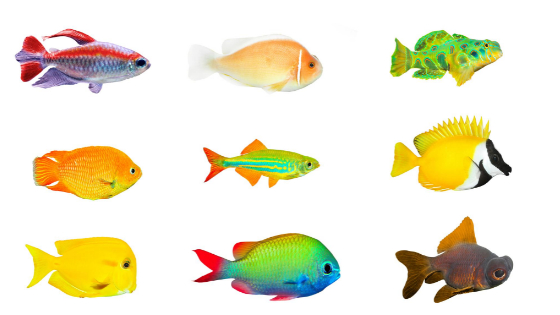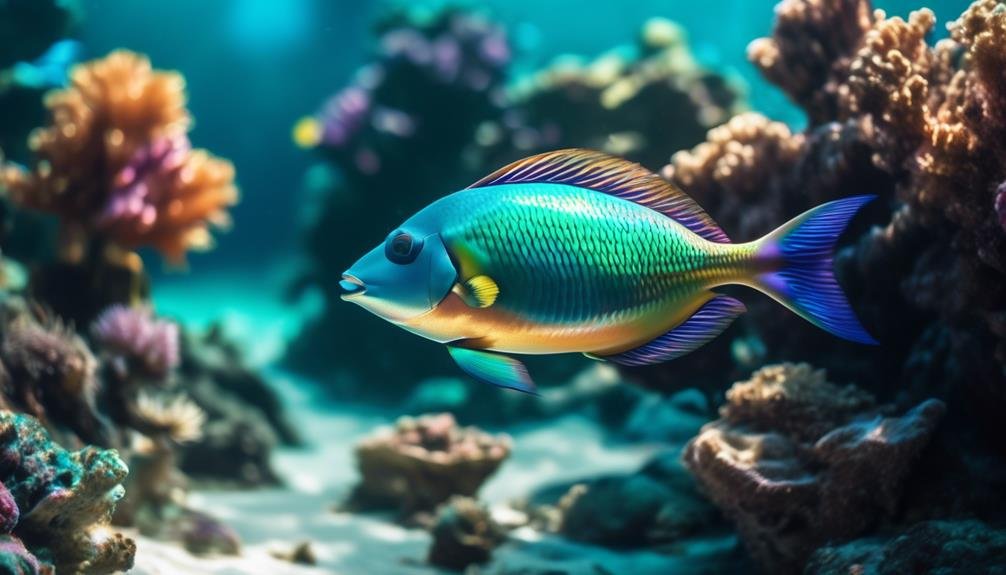
Step into the dazzling underwater world and discover the captivating beauty of the unicornfish. Like a shimmering gem hidden beneath the ocean’s surface, these mysterious creatures entice with their vibrant colors and enchanting patterns.
But there’s more to these aquatic jewels than meets the eye. As you dive deeper, you’ll uncover the secrets of their origins, their unique characteristics, and the challenges of caring for these exotic beings.
So, prepare to be mesmerized as we embark on a journey to unravel the mysteries of the colorful and mysterious unicornfish.
Key Takeaways
- Unicornfish are a diverse group of species with about 20 different types.
- While most unicornfish are drab in color, there are three species that are brightly colored.
- Unicornfish require large aquariums with plenty of swimming space and slightly alkaline water conditions.
- They have different dietary preferences, but most species primarily feed on algae. Breeding them in captivity is challenging due to their long larval phase.
Unicornfish Characteristics
Unicornfish, belonging to the genus Naso, are characterized by a long pointed protuberance in the middle of their heads. This unique feature sets them apart from other fish species.
With around 20 different species, unicornfish can be found in tropical locations across the globe, particularly in the Indo-Pacific region. While they can become aggressive and territorial with their own kind, they’re generally peaceful and non-combative with other non-aggressive saltwater species of similar size.
When it comes to their coloration, most unicornfish species are drab in color, but there are three species that stand out with their bright colors.
In terms of care, unicornfish require large aquariums with plenty of swimming space and prefer tropical temperatures and slightly alkaline pH.
Origins and Distribution
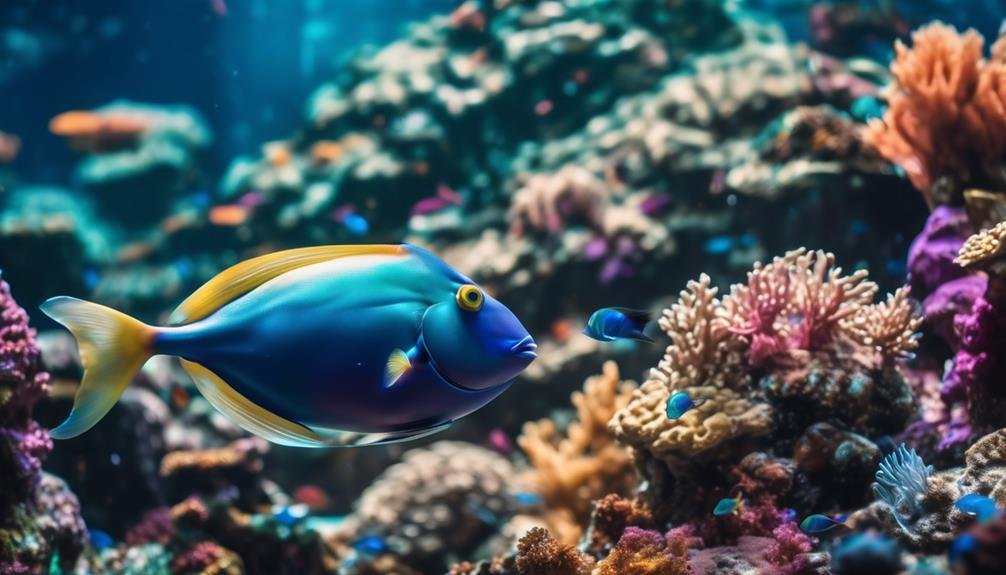
Found in tropical locations around the globe, unicornfishes are commonly distributed in the Indo-Pacific region ranging from Hawaii to Africa. These vibrant and mysterious creatures can be found in various coral reef habitats, including lagoons, outer reefs, and drop-offs.
They’re often seen swimming in schools near the reef edges, feeding on algae and other plant material. Some species of unicornfish have also been observed in seagrass beds and rocky areas.
The Indo-Pacific region offers a diverse range of marine environments, providing ample food sources and suitable conditions for the unicornfish to thrive. Their wide distribution throughout this region demonstrates their adaptability and ability to survive in different ecosystems.
Coloration
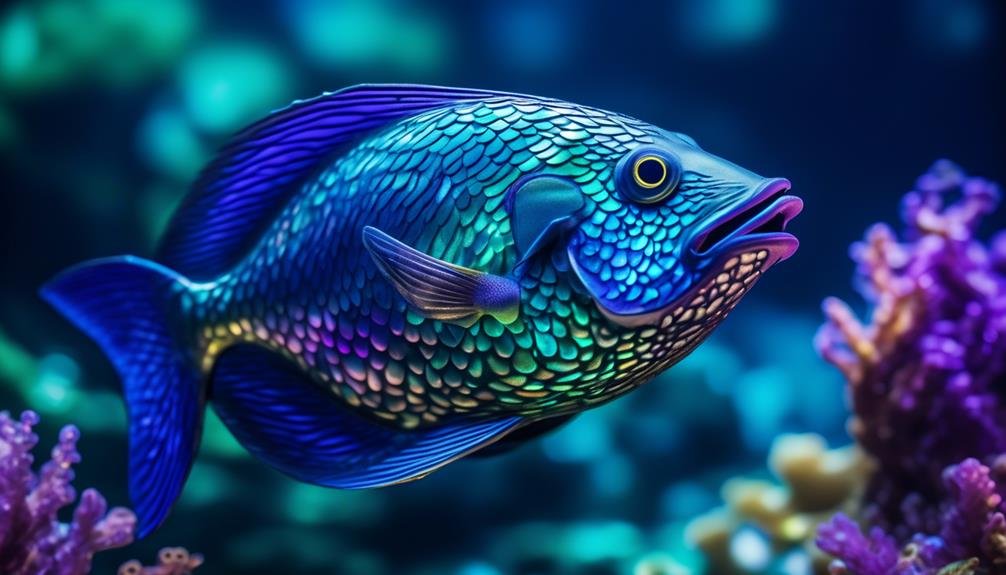
As we shift our focus to the subtopic of ‘Coloration’, let’s explore the captivating and diverse array of hues that adorn these remarkable unicornfish. While many unicornfish species are drab in color, there are three species that truly stand out with their vibrant shades. The Elegant Unicornfish, Bignose Unicornfish, and Orange Spine Unicornfish showcase a stunning display of colors that range from vivid blues and greens to vibrant oranges and yellows. To emphasize the beauty of these colors, let’s take a look at the following table:
| Species | Coloration |
|---|---|
| Elegant Unicornfish | Vivid blues, greens |
| Bignose Unicornfish | Vibrant oranges |
| Orange Spine Unicornfish | Vibrant yellows |
These colorful unicornfish not only add a touch of brilliance to the underwater world, but also serve as a reminder of the incredible diversity found in our oceans.
Maintenance and Care
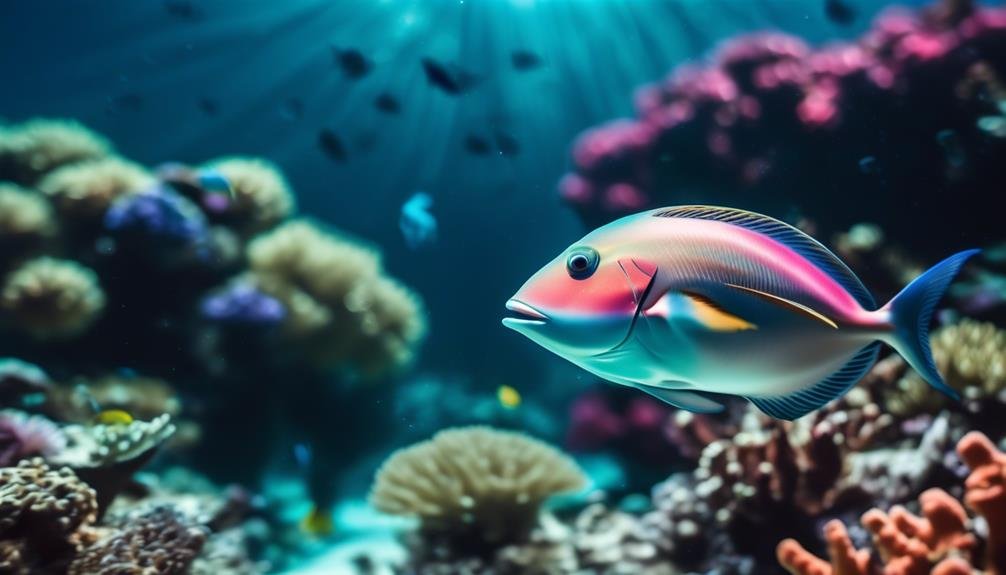
To properly care for unicornfish, it’s essential to provide them with a spacious and well-maintained aquarium. These fish require a large tank as they’re very active swimmers. Make sure to place tank decorations towards the edges to leave plenty of space in the middle for them to swim freely.
Unicornfish prefer tropical temperatures and slightly alkaline pH levels, so it’s important to maintain these conditions in the tank. Additionally, water hardness should be moderate.
When it comes to feeding, different species of unicornfish have different dietary preferences, but most primarily feed on algae. You can also supplement their diet with fresh and frozen foods like brine shrimp and mysis shrimp.
Breeding unicornfish in captivity can be challenging due to their long larval phase.
Feeding Habits
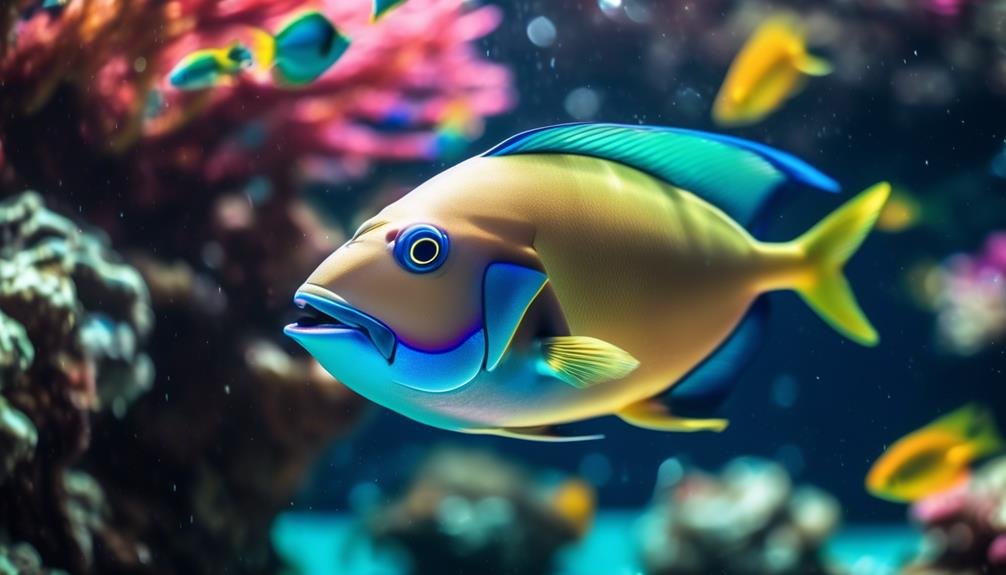
When caring for unicornfish, it’s important to understand their unique feeding habits. Different species of unicornfish have different dietary preferences. Most species primarily feed on algae, which makes up the majority of their diet. They’ve specialized teeth that allow them to scrape and graze on algae-covered surfaces, such as rocks and coral.
Some unicornfish will also accept fresh and frozen foods like brine shrimp and mysis shrimp. It’s recommended to provide them with a variety of foods to ensure a balanced diet. Algae flakes and wafers should be provided as a staple food source.
It’s important to monitor their feeding to prevent overeating, as unicornfish can be prone to obesity. Understanding and meeting their dietary needs will help keep unicornfish healthy and thriving in your aquarium.
Breeding Challenges
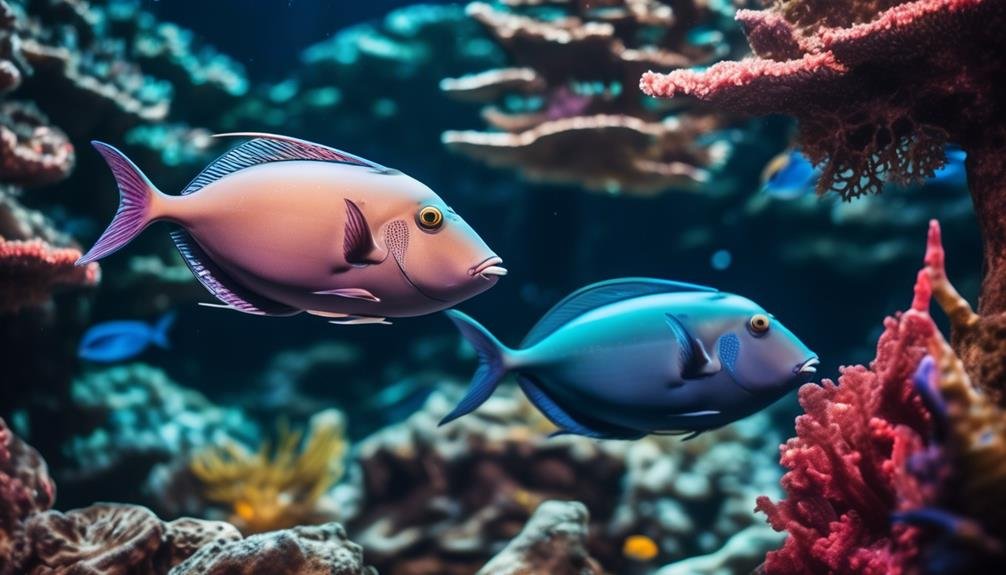
Breeding unicornfish in captivity presents significant challenges due to their long larval phase and specific environmental requirements. Unicornfish have a unique reproductive process that involves a lengthy larval stage, making it difficult to successfully breed them in a controlled setting. Additionally, these fish have specific needs when it comes to their environment, further complicating the breeding process.
One of the main challenges is replicating the natural conditions that trigger spawning. Unicornfish require specific water parameters, such as temperature, salinity, and pH levels, to induce breeding behavior. Maintaining these conditions in a captive environment can be quite challenging.
Another hurdle is the long larval phase of unicornfish. During this stage, the larvae are highly sensitive and require specialized care to ensure their survival. The larvae need a steady supply of appropriate food, such as zooplankton, to grow and develop properly. Providing the necessary nutrition for the larvae can be a difficult task in a captive setting.
Overall, breeding unicornfish in captivity requires meticulous attention to detail and a thorough understanding of their unique reproductive needs. Only with the right conditions and care can successful breeding be achieved.
| Breeding Challenges | Solutions |
|---|---|
| Replicating natural spawning conditions | Careful monitoring and adjustment of water parameters |
| Providing appropriate nutrition for larvae | Ensuring a steady supply of zooplankton |
| Caring for the sensitive larvae | Implementing specialized care techniques |
| Achieving successful breeding | Thorough understanding of unicornfish reproductive needs |
Conservation Efforts
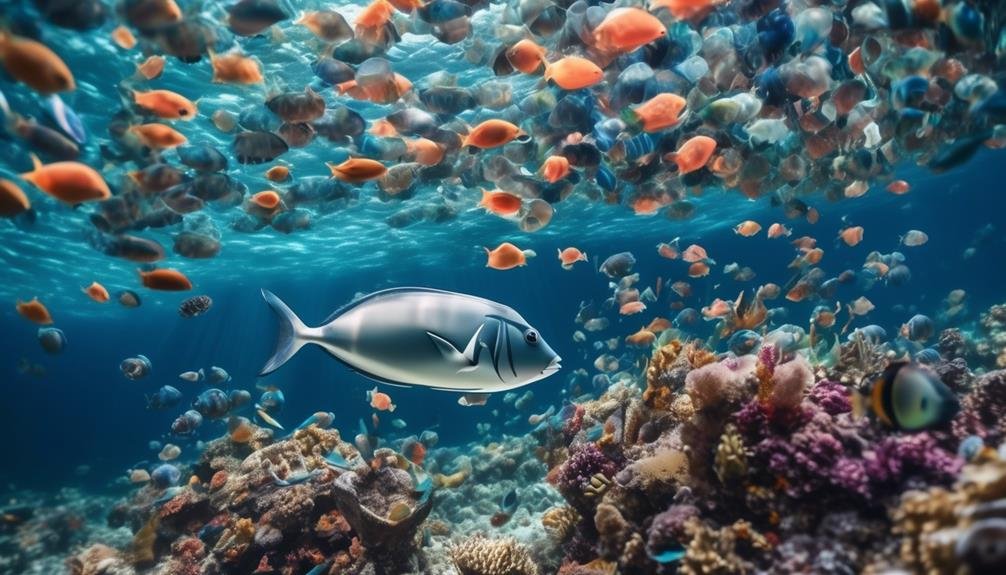
Conservation efforts play a crucial role in protecting and preserving the unique and diverse unicornfish species. These efforts are essential for maintaining the delicate balance of the aquatic ecosystem and ensuring the long-term survival of these magnificent creatures.
Here are three key reasons why conservation efforts are vital:
- Habitat Preservation: Unicornfish rely on specific coral reef habitats for food and shelter. By conserving these habitats, we can ensure that unicornfish have a suitable environment to thrive in.
- Sustainable Fishing Practices: Implementing sustainable fishing practices, such as size and catch limits, helps prevent overfishing and ensures that unicornfish populations can replenish and sustain themselves.
- Education and Awareness: Educating the public about the importance of unicornfish conservation can foster a sense of responsibility and encourage individuals to take action. This increased awareness can lead to greater support for conservation initiatives and ultimately contribute to the preservation of these magnificent creatures for future generations.
Frequently Asked Questions
What Is the Average Lifespan of a Unicornfish?
The average lifespan of a unicornfish is typically around 10 to 15 years. However, with proper care and a healthy environment, they can live up to 20 years or more.
Can Unicornfish Change Their Coloration?
Yes, unicornfish can change their coloration. Some species are drab in color, but there are three brightly colored species. They have the ability to change their colors based on their mood and environment.
Are There Any Known Predators of Unicornfish?
Yes, there are known predators of unicornfish. Sharks, barracudas, and large predatory fish are some examples. Unicornfish use their speed and maneuverability to avoid being caught by these predators in their natural habitats.
How Do Unicornfish Communicate With Each Other?
Unicornfish communicate with each other through various visual cues, such as body coloration and fin movements. They use these signals to establish dominance, defend territory, and attract mates. Communication plays an important role in their social interactions.
What Is the Significance of the Long Pointed Protuberance on the Heads of Unicornfish?
The long pointed protuberance on the heads of unicornfish is significant because it helps them attract mates and establish dominance within their own species. It is a unique feature that sets them apart from other fish.
What Makes Unicornfish and Cardinalfish Different in terms of Aquatic Beauty and Adaptability?
The colorful cardinalfish in the sea stand out for their vibrant hues and intricate striped patterns, making them a stunning addition to any coral reef. Their adaptability allows them to thrive in a variety of aquatic environments. In contrast, unicornfish boast striking horn-like protrusions and distinctive coloring, making them equally captivating.
Conclusion
So there you have it, the captivating world of unicornfish! These colorful and mysterious aquatic jewels bring beauty and wonder to the tropical waters of the Indo-Pacific region. From their distinct long pointed protuberance to their vibrant hues, unicornfish are truly a sight to behold.
Maintaining these fascinating creatures in an aquarium requires careful attention to their specific needs, but the rewarding experience is well worth it.
Join us in appreciating and preserving the enchanting world of unicornfish.




